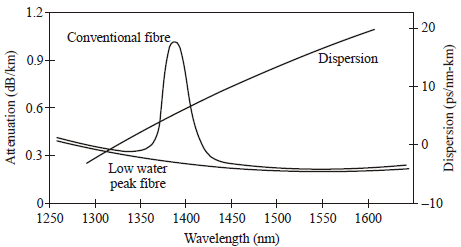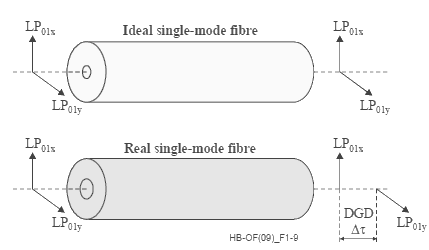Cables Attributes:attenuation
Cables attributes:Attenuation: Cable attributes are those recommended for cables as they are delivered.
Attenuation: The attenuation A(λ) at wavelength λ of a fibre between two cross-sections, 1 and 2, separated by distance L is defined, as:

For a uniform fibre, it is possible to define attenuation per unit length, or an attenuation coefficient which is independent of the length of the fibre:
![]()
The attenuation coefficient depends on the wavelength of transmitted light. Figure 1 shows the attenuation spectrum of a conventional and of a low water peak fibre.
 fig..(1)Attenuation of an optical fibreThe conventional fibre exhibits a secondary minimum around 1 310 nm and an absolute minimum near 1 550 nm. In older fibre (e.g. ITU-T G.652.B) a strong peak of attenuation was present around 1 383 nm due to the presence of the residual water vapour in silica (OH ion). In modern low water peak fibre
fig..(1)Attenuation of an optical fibreThe conventional fibre exhibits a secondary minimum around 1 310 nm and an absolute minimum near 1 550 nm. In older fibre (e.g. ITU-T G.652.B) a strong peak of attenuation was present around 1 383 nm due to the presence of the residual water vapour in silica (OH ion). In modern low water peak fibre
(e.g. ITU-T G.652.D) the concentration of the OH ion is drastically reduced and the attenuation peak around 1 383 nm has practically disappeared. The low water peak fibre allow the possibility of using a larger wavelength range in respect of older fibres, in particular for WDM system applications. The attenuation coefficient is specified with a maximum value at one or more wavelengths in both the 1 310 nm and 1 550 nm regions. The attenuation coefficient may be calculated across a spectrum of wavelengths, based on measurements at a few (3 to 4) predictor wavelengths. This procedure is described in Recommendation ITU-T G.650.1 and an example is given in Recommendation ITU-T G.650.1.
Polarization mode dispersion: Polarization mode dispersion (PMD) is related to the differential group delay (DGD), the time difference in the group delays between two orthogonal polarized modes, which causes pulse spreading in digital systems and distortions in analogue systems. In ideal circular symmetric fibres, the two polarization modes propagate with the same velocity. However, real fibres cannot be perfectly circular and can undergo local stresses; consequently, the propagating light is split into two polarization modes (Figure 1)

Figure 1 – DGD due to the two polarization modes propagating at different velocities